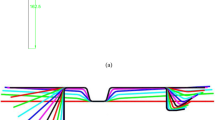Abstract
In the cold roll forming process, the sheet metal strip is gradually bent into a desired profile by successive roller stations. During this process the roller locating errors of each roller station are introduced, transformed and accumulated until the sheet metal is bent into the final desired profile, which does influence the product’s dimension quality, affect the end-welding of quadrate steel tube, and elongate the costly error-and-trial phase in ramp-up. This paper introduces procedures for expressing the influence of roller locating errors in the forming process of quadrate steel tube, which is based on the formulation of the stream of variation (SOV) model of roller dimensional errors using the CAD/CAPP parameters of the cold roll forming process. The SOV model is utilized to reveal the variation propagation in the manufacturing process. The modeling process is experimentally validated in a two-station forming process.
Similar content being viewed by others

Reference
Kiuchi M, Koudabashi T (1983) “Roll forming of circular tubes- automated design system of optimal roll profiles”. Proc. International Conference and Energy Eurogress - Aachen Germany
Nitin Duggal, Mustafa AA, Gary LK, Taylan A (1996) “Computer aided simulation of cold roll forming - a computer program for simple section profiles”. J Mater Process Tech 59:41–48
Bhattacharyya D, Smith PD, Yee CH, Collins IF (1984) “The prediction of deformation length in cold roll forming”. J Mech Work Technol 9:181–191
Kiuchi M, Koudabashi T (1984) “Automated design system of optimal roll profiles for cold roll forming”. Proc. the third international conference on rotary metalworking processes, Kyoto, Japan 423–436
Kiiuchi M, Abe K, Onodera R (1996) “Computerized numerical simulation of roll forming process”. Proc. the Fifth ICTP, Columbus, OH 493–496
Panton SM (1987) “Computer-aided form roll design”. Ph.D. Thesis, University of Aston, Birmingham
Panton SM, Zhu SD, Duncan JL (1996) “Longitudinal and shear strain development in cold roll forming”. J Mater Process Tech 60:219–224
Brunet M, Mguil S, Pol P (1998) “Modelling of a roll-forming process with a combined 2D and 3D FEM code”. J Mater Process Tech 80–81:213–219
Farzin M, Salmani TM, Shameli E (2002) “Determination of buckling limit of strain in cold roll forming by the finite element analysis”. J Mater Process Tech 125–126:626–632
Alsamhan A, Pillinger I, Hartely P (2004) “The development of real time re-meshing technique for simulating cold-roll-forming using FE methods”. J Mater Process Tech 147:1–9
Zhi-Wu H, Cai L, Wei-Ping L, Lu-Quan R, Jin T (2005) “Spline finite strip analysis of forming parameters in roll forming a channel section”. J Mater Process Tech 159:383–388
Hu SJ (1997) “Stream of variation theory for automotive-body assembly”. CIRP Ann 46(1):1–6
Hu S, Wu SM (1992) “Identifying root causes of variation in autobody assembly using principal component analysis”. Transactions of NAMRI 20:311–316
Roan CM, Hu SJ (1995) “Monitoring and classification of dimensional faults in automotive body assembly”. Int J Flex Manuf Syst 7(2):103–125
Ceglarek D, Shi J (1995) “Dimensional variation reduction for automotive body assembly”. Manuf Rev 8:139–154
Ceglarek D, Shi J (1996) “Fixture failure diagnosis for the autobody assembly using pattern recognition”. ASME J Ind Eng 118(1):55–66
Yang K (1996) “Improving automotive dimensional quality by using principal component analysis”. Qual Reliab Eng Int 12(6):401–409
Jin J, Shi J (1999) “State of variation theory for automotive-body assembly”. CIRP Ann 46(1):1–6
Ding Y, Ceglarek D, Shi J (2000) “Modelling and diagnosis of multi-stage manufacturing processes, Part I-State space model”, Japan-USA Symposium, Ann Arbor, Michigan
Ding Y, Ceglarek D, Shi J (2000) “Modelling and diagnosis of multi-stage manufacturing processes, Part II-Fault diagnosis”, Japan-USA Symposium, Ann Arbor, Michigan
Ding Y, Ceglarek D, Shi J (2002) “Fault diagnosis of multi-stage manufacturing processes by using state space approach”. ASME J Manuf Sci Eng 124:313–322
Ding Y, Shi J, Ceglarek D (2002) “Diagnosability analysis of multi-station manufacturing processes”. ASME J Dyn Syst Meas Control 124:1–13
Ding Y, Pansoo K, Ceglarek D, Jionghua J (2003) “Optimal sensor distribution for variation diagnosis in multi-station assembly processes”. IEEE Trans Robot Autom 19(4):543–556
Liu C, Ding Y, Chen Y (2005) “Optimal coordinate sensor placements for estimating mean and variance components of variation sources”. IIE Trans 37(9):877–889
Huang Q, Zhou N, Shi J (2000) “Stream of variation modeling and diagnosis of multi-station machining processes”. Proc. of IMECE 2001, Orlando, FL
Djurdjanovic D, Ni J (2001) “Linear state space modeling of dimensional machining errors”. Trans Of NAMRI/SME 29:541–548
Zhou S, Huang Q, Shi J (2003) “State space modeling of multi-stage machining systems by using differential motion vector”. IEEE Trans Rob Autom:19(2):296–309
Djurdjanovic D (2002) “Stream of variation modelling of machining errors and its applications”. Doctoral Dissertation, University of Michigan
Djurdjanovic D, Ni J (2001) “Stream of variation based analysis and synthesis of measurement schemes in multi-station machining systems”. Proc. of the ASME IMECE
Djurdjanovic D, Ni J (2003) “Dimensional errors of fixtures, locating and measurement datum features in the stream of variation modeling in machining”. ASME J Manuf Sci Eng 125:716–730
Ceglarek D, Huang W, Zhou S, Ding Y, Kumar R, Zhou Y (2004) “Time-based competition in multistage manufacturing: Stream-of-variation analysis (SOVA)”. Int J Flex Manuf Syst 16:11–14
Author information
Authors and Affiliations
Corresponding author
Rights and permissions
About this article
Cite this article
Zhang, L., Ni, J. & Lai, X. Dimensional errors of rollers in the stream of variation modeling in cold roll forming process of quadrate steel tube. Int J Adv Manuf Technol 37, 1082–1092 (2008). https://doi.org/10.1007/s00170-007-1066-0
Received:
Accepted:
Published:
Issue Date:
DOI: https://doi.org/10.1007/s00170-007-1066-0



